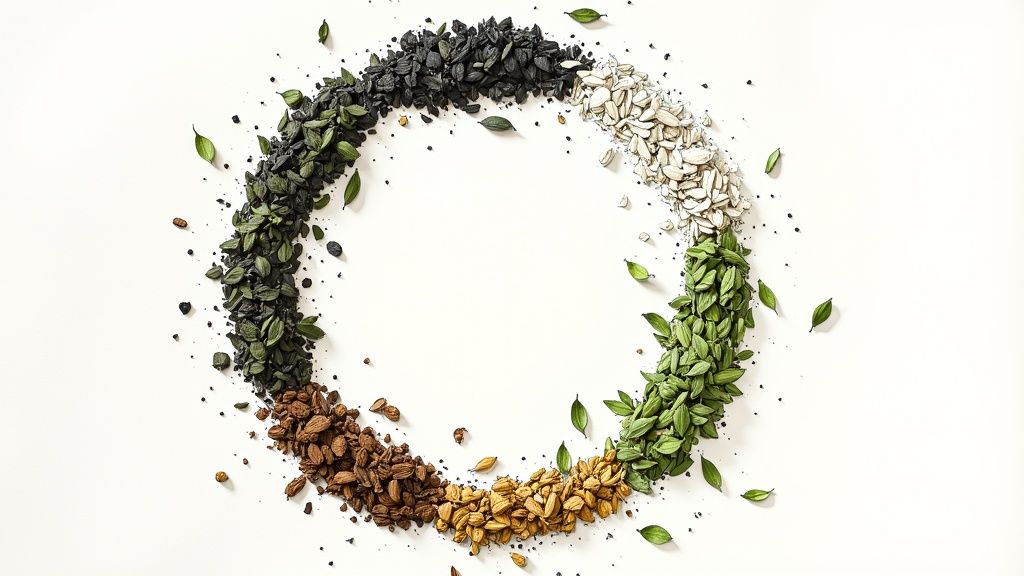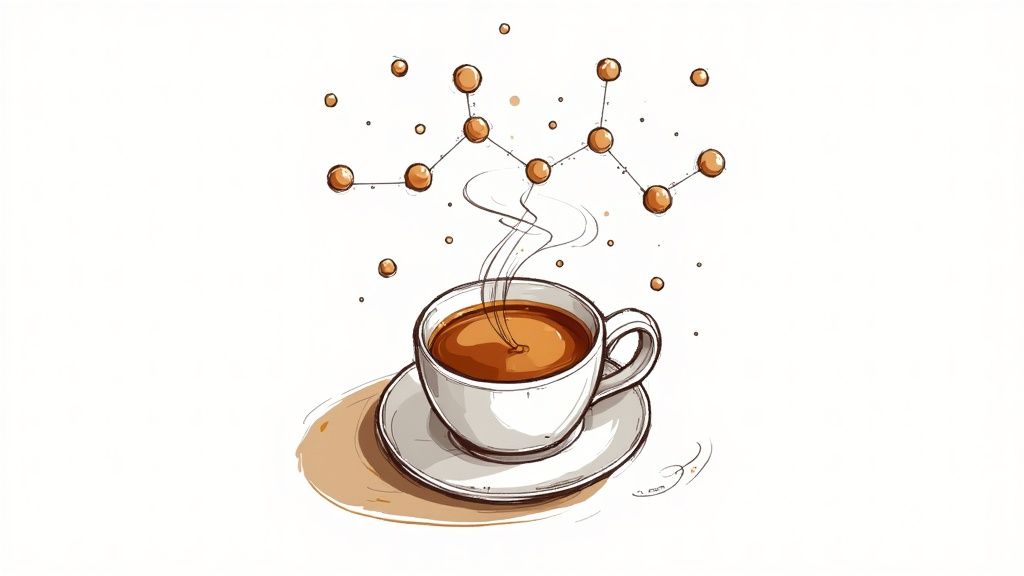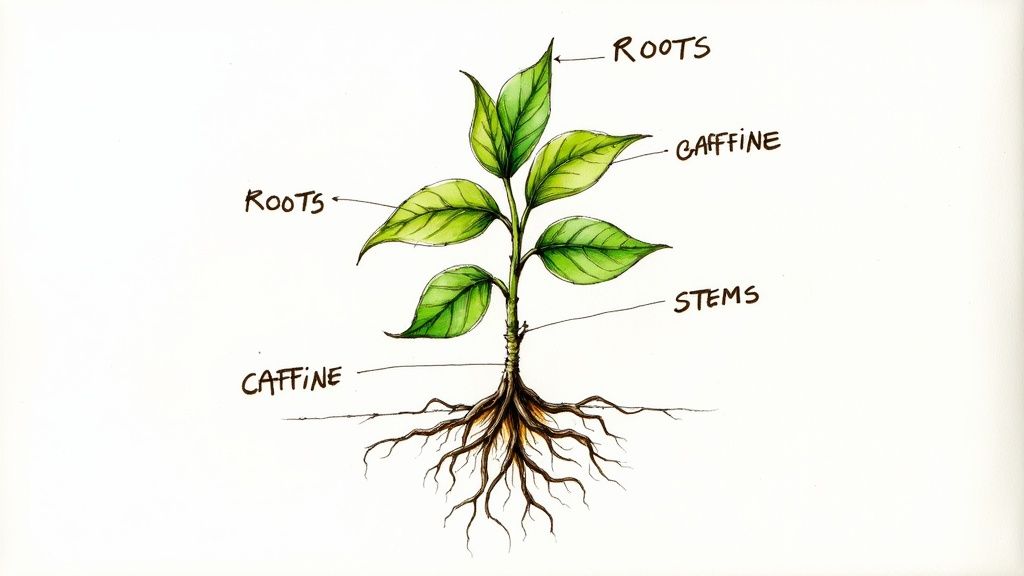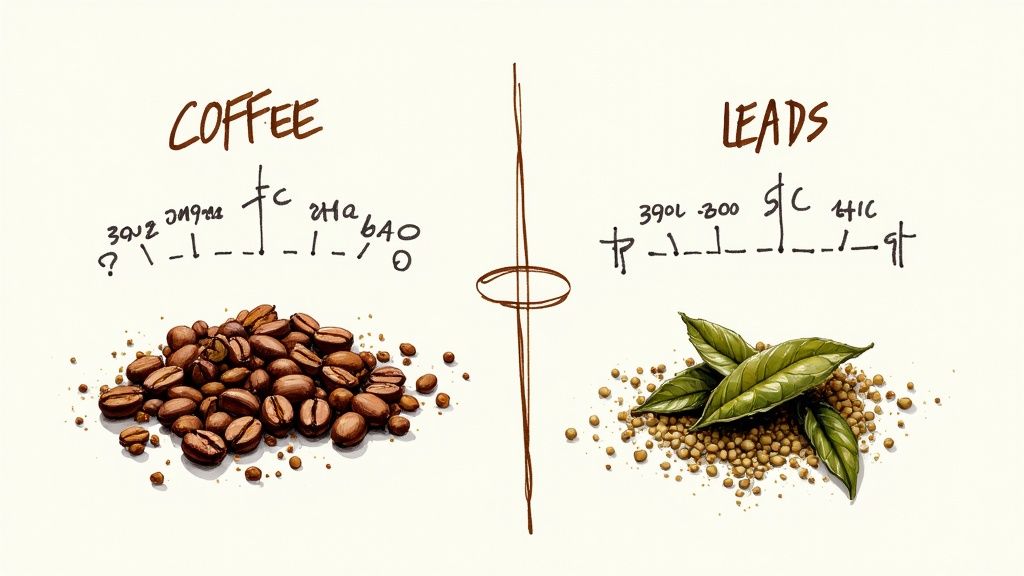The Truth About Caffeine Levels in Different Teas

When it comes to tea and caffeine content, common beliefs often miss the mark. Many people think all teas contain similar amounts of caffeine, or that darker teas pack more punch. The reality is much more interesting – caffeine levels in tea depend on several key factors that work together in surprising ways.
Oxidation and Caffeine: A Surprising Relationship
Tea leaves go through a process called oxidation, where exposure to air causes chemical changes and darkening. While you might expect more oxidized teas to have more caffeine, the numbers tell a different story. Take white tea, which undergoes minimal oxidation – it can contain anywhere from 6-60mg of caffeine per cup. Green tea, with its light oxidation, typically provides 20-45mg per cup. Black tea, which is fully oxidized, generally delivers 47-90mg per cup. These wide ranges within each type show that other elements besides oxidation affect caffeine content.
Beyond Oxidation: Other Factors Affecting Caffeine
Just like different apple varieties have unique flavors despite being the same fruit, tea plants produce varying caffeine levels based on several factors. Growing conditions play a major role – things like soil quality, climate, and altitude all affect the tea plant's chemistry. Young tea leaves tend to pack more caffeine than mature ones. Even tea plants of the same variety can produce different caffeine amounts depending on these variables, making it tricky to predict exact caffeine content for any given tea.
Brewing and Caffeine Extraction
How you prepare your tea has a big impact on its final caffeine content. Think of it like cooking – the longer you steep tea and the hotter the water, the more caffeine ends up in your cup. For example, steeping black tea briefly in warm water will give you less caffeine than brewing it for several minutes in hot water. This applies to all types of tea. Using tools like Brew Timer helps achieve consistent results. Rather than relying on general caffeine claims, understanding how tea type, growing conditions, and brewing methods work together gives you better control over your tea's caffeine content.
The Hidden Science of Tea's Caffeine

Tea's caffeine content is fascinating and more complex than most people realize. The story begins with the tea plant itself and its clever natural defense system. Tea plants produce caffeine as a natural pesticide to protect their youngest, most tender leaves from insects. Interestingly, these same young leaves that contain the most caffeine are the ones we prize most for brewing tea.
From Plant to Cup: How Growing Conditions and Processing Affect Caffeine
Just like wine grapes take on different characteristics based on where they grow, tea leaves' caffeine levels change with their growing environment. The altitude of the tea garden, local weather patterns, and soil quality all influence how much caffeine develops in the leaves. Tea plants growing at higher elevations tend to grow more slowly and produce leaves with more concentrated caffeine. The timing of the harvest also matters – the first few leaves picked from each branch pack significantly more caffeine than older leaves further down the stem.
After picking, each step of processing shapes the tea's final caffeine content. While many people focus on oxidation levels, other steps like withering, rolling, and drying all play important roles too. Take green tea as an example – it goes through minimal processing and usually contains less caffeine than fully oxidized black tea. But there's plenty of variation within each type of tea, showing how growing conditions and processing methods work together to create the final product.
Decoding the Caffeine in Your Cup
This complexity means that two different black teas can deliver quite different caffeine kicks, even if they look identical in your cup. How you brew your tea also makes a big difference in how much caffeine ends up in your drink. Water temperature and steeping time work like dials that control caffeine extraction – hotter water and longer steeping pull out more caffeine, similar to how herbs release more flavor the longer they cook. A handy tool like Brew Timer can help you brew consistently every time.
You might be interested in: How is Matcha Tea Different From Standard Green Tea and Other Brews? Matcha offers a unique perspective on tea and caffeine. Since you consume the whole leaf rather than just an infusion, matcha typically delivers more caffeine than other teas. Many people find that matcha's caffeine creates a gentler, longer-lasting energy boost compared to other caffeinated drinks. Understanding these various factors helps you make better choices about which teas to drink and when to drink them throughout your day.
Mastering Caffeine Through Brewing Techniques
The amount of caffeine in your tea depends heavily on how you prepare it. While tea type matters, brewing methods can dramatically change caffeine levels in each cup. Making small adjustments to how you steep your tea gives you greater control over your caffeine intake.
Key Brewing Variables and Their Impact on Caffeine
Like cooking any dish, specific variables affect how much caffeine ends up in your tea:
- Water Temperature: Just as hot water dissolves sugar more quickly than cold water, higher temperatures pull more caffeine from tea leaves into your cup.
- Steeping Time: The simple rule is that longer steeping releases more caffeine. The more time tea leaves spend in water, the more caffeine moves from leaf to liquid.
- Leaf Ratio: Using more tea leaves creates more surface area for caffeine extraction. More leaves mean more caffeine can potentially enter your cup.
Fine-Tuning Your Brew for Desired Caffeine Levels
Once you understand these key factors, you can adjust your brewing to match your caffeine needs. Want less caffeine in your black tea? Try water at 190°F instead of boiling and steep for 2-3 minutes rather than 4-5. Need an extra boost from green tea? Add more leaves and extend the steeping time slightly. Apps like Brew Timer help track steeping time precisely.
Common Brewing Mistakes That Increase Caffeine
Watch out for these common mistakes that can unexpectedly boost caffeine content:
- Over-Steeping: It's easy to forget about steeping tea when you're busy, but leaving leaves in too long leads to high caffeine levels.
- Using Boiling Water for All Teas: While black tea handles boiling water well, it can damage delicate green or white teas and release more caffeine than intended.
- Ignoring Leaf Ratios: Adding too many leaves is an easy way to end up with more caffeine than planned. Follow recommended amounts, especially with unfamiliar teas.
Achieving Consistency in Every Cup
Creating reliable, repeatable brews means paying attention to details. Use consistent water sources, measure leaves carefully, and time your steeps. Getting these basics right leads to better-tasting tea and predictable caffeine content. Taking control of these brewing elements helps you make informed choices about your caffeine intake while enjoying better tea.
Tea vs. Coffee: The Caffeine Reality Check

Many people wonder about the caffeine differences between tea and coffee. While both drinks contain caffeine, they affect your body in distinct ways. Let's look at what science tells us about how these beverages compare.
Comparing Caffeine Levels: A Tale of Two Beverages
Tea's caffeine content changes based on type and brewing method, but most teas contain around 90mg of caffeine per cup at most. Coffee packs more punch – a regular cup typically has 150-200mg of caffeine, which is why it gives you that stronger energy boost. These different caffeine levels explain why each drink makes you feel differently after drinking them.
Beyond the Numbers: Why Coffee's Caffeine Feels Different
Here's something surprising – before brewing, tea leaves actually contain more caffeine than coffee beans. The difference comes down to how we make each drink. Coffee brewing pulls out caffeine more effectively than tea steeping does. Plus, coffee cups are usually bigger than teacups, so you end up consuming more caffeine overall. That's why coffee tends to hit you faster and harder than tea does.
The L-theanine Factor: Tea's Secret Weapon
Tea has a special ingredient that coffee doesn't – L-theanine, an amino acid that helps you stay relaxed while staying alert. When L-theanine works together with caffeine in tea, it creates a smooth, focused energy without the jitters that coffee sometimes causes. This makes tea perfect for when you need to concentrate without feeling anxious or wired.
Making Informed Choices: Tea or Coffee?
Knowing these differences helps you pick the right drink for different situations. Need quick energy for an early meeting? Coffee might work best. Want steady focus for a long work session? Try green tea instead. Pay attention to how your body reacts to caffeine when choosing between them. Using tools like Brew Timer can help you make consistent cups of tea and control your caffeine intake. This knowledge lets you get the most out of both drinks while managing your energy levels throughout the day.
Optimizing Tea's Caffeine Benefits

Now that we understand how caffeine works in tea and the effects of brewing, let's explore practical ways to get the most benefit from your daily cup. Making smart choices about when and how you drink tea can help you stay energized and focused throughout your day.
The Caffeine-L-theanine Synergy: A Balanced Boost
What makes tea special is how caffeine works together with L-theanine, a natural amino acid that promotes calmness and mental clarity. While coffee might give you a sudden jolt of energy, tea provides a gentler lift that helps you stay alert without feeling jittery. The L-theanine balances out caffeine's stimulating effects, making tea an excellent choice when you need to concentrate on work or creative projects. Many people find this combination helps them stay productive without the anxiety or crash that sometimes comes with coffee.
Timing Your Tea Intake: Matching Tea Type to Your Needs
By knowing the caffeine levels in different teas, you can choose the right type for different times of day. Start your morning with black tea for an energizing boost similar to coffee, but with a smoother effect that lasts longer. When you need an afternoon pick-me-up, try green tea – it has less caffeine than black tea but enough to keep you alert without disrupting your sleep later. End your day with caffeine-free herbal tea to help you wind down and relax before bed.
Personalizing Your Tea Routine: Listening to Your Body
Everyone responds differently to caffeine, so it's important to pay attention to how tea affects you personally. Some people feel energized after just one cup, while others can drink several with no issues. Watch for signs that you might be sensitive to caffeine, such as feeling restless, anxious, or having trouble sleeping. If you notice these effects, try switching to teas with less caffeine or adjusting when you drink them during the day.
To control your caffeine intake more precisely, experiment with brewing times and methods. Using a Brew Timer helps you brew consistently every time. Try different tea varieties and brewing techniques until you find what works best for you. The key is creating a tea routine that fits your schedule and makes you feel your best – whether that means a strong morning black tea, a gentle afternoon green tea, or a mix throughout the day.
Beyond Caffeine: Your Guide to Zero-Caffeine Options
Not everyone wants or needs caffeine in their tea. Whether you're sensitive to stimulants or simply prefer to avoid them, there are many excellent caffeine-free options to explore. Let's look at what makes a beverage truly caffeine-free and discover some delicious alternatives.
Understanding "Caffeine-Free"
There's an important difference between "decaffeinated" and "caffeine-free" drinks. When a tea is decaffeinated, it means the caffeine has been removed through processing, though small amounts may remain. Natural caffeine-free beverages come from plants that never contained caffeine in the first place. This matters especially for people who need to completely avoid caffeine for health reasons.
Exploring Herbal Infusions
What we call "herbal teas" aren't actually teas at all. True teas – black, green, white, oolong, and pu-erh – all come from one plant: Camellia sinensis. Herbal infusions instead use different plants, from soothing chamomile flowers to zesty peppermint leaves to warming ginger root. Each brings its own unique flavor and character to your cup.
Building a Satisfying Caffeine-Free Tea Routine
Going caffeine-free doesn't mean giving up your daily tea ritual. You can create equally meaningful moments throughout your day with herbal options:
- Morning Ritual: Wake up with bright peppermint or spicy ginger to energize naturally
- Afternoon Calm: Take a midday break with gentle chamomile or lavender
- Evening Relaxation: End your day with smooth rooibos or calming herbs like valerian
By matching specific herbs to different times of day, you can maintain the comfort and structure of a tea routine without caffeine.
Herbal Infusion Benefits Beyond Caffeine
Many herbal teas offer unique health properties:
| Herbal Infusion | Potential Benefits |
|---|---|
| Peppermint | Digestive aid, headache relief |
| Chamomile | Relaxation, sleep aid |
| Ginger | Nausea relief, anti-inflammatory |
| Hibiscus | Antioxidant, may lower blood pressure |
| Rooibos | Antioxidant, may improve bone health |
To get the most from your herbal infusions, proper steeping time matters. The Brew Timer app can help you achieve consistent results cup after cup.
Ready to dive deeper into specialty teas? Visit matcha-tea.com for high-quality matcha, helpful articles, and recipes that will expand your tea horizons.
